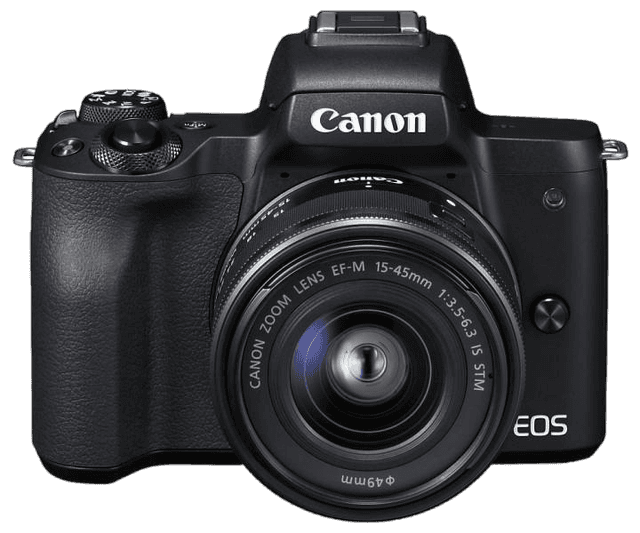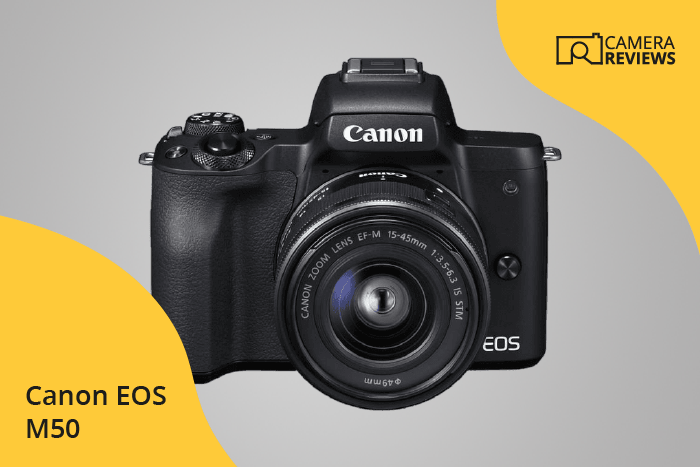Canon EOS M50 Specs and Scores

The Canon EOS M50 scores a 59/100 in our evaluation. Launched in 2018, it measures 116 x 88 x 59mm and weighs 390g (0.86lbs). The EOS M50’s specifications are decent for a camera released a few years ago. However, considering the advancements in today’s market, it may not be the top choice for those seeking cutting-edge technology. Nonetheless, the Canon EOS M50 remains a reliable option for casual photography enthusiasts.
Canon EOS M50 Overview and Optics
The optics of the Canon EOS M50 receives a score of 59/100. This camera features 24 megapixels, a shooting speed of 10, and a CMOS sensor type. Powered by the Digic 8 processor, the sensor size is APS-C and the lens mount is Canon EF-M. There is no image stabilization, and the aspect ratio is 3:2.
In comparison to other cameras in the market, the Canon EOS M50 offers decent specifications. While the megapixel count and shooting speed are sufficient for casual photography, the lack of image stabilization may deter some users. The Digic 8 processor ensures fast processing and good image quality, but the DXOMARK score of 58 indicates that the sensor performance is average.
The Canon EOS M50 is a solid choice for those seeking an entry-level camera with good specifications. However, for those seeking advanced features or exceptional sensor performance, other options may be more suitable. The optics of the M50 are satisfactory but may not be sufficient for professional or advanced users.
Canon EOS M50 Video Performance
The Canon EOS M50 boasts an impressive video score of 91 out of 100. This high score showcases its excellent video capabilities, which include a maximum video resolution of 4K and dimensions of 3840 x 2160. The camera also supports a maximum video frame rate of 120fps, allowing users to capture smooth and detailed footage in various situations.
In today’s market, the M50’s video specifications are competitive, as 4K resolution has become a standard feature among high-quality cameras. The inclusion of time-lapse functionality further enhances the camera’s versatility, catering to various creative needs of users.
The Canon EOS M50 is a strong contender in the market with its exceptional video capabilities, making it a top choice for individuals looking for a reliable camera to capture stunning video content.
Canon EOS M50 Features and Benefits
The Canon EOS M50 receives a feature score of 70/100. This camera boasts a 3-inch screen with a resolution of 1,040,000 dots, ensuring clear and detailed image previews. The touchscreen capability enhances user experience, allowing for easy navigation and control. Additionally, the flip screen provides flexibility for capturing images from various angles.
Despite lacking GPS functionality, the EOS M50 compensates with its WIFI and Bluetooth capabilities. These features enable seamless photo sharing and remote camera control, making it a convenient choice for modern photographers.
When compared to other cameras in today’s market, the Canon EOS M50 offers a solid set of features that cater to both beginners and enthusiasts. Its combination of a high-resolution, touchscreen flip screen, and wireless connectivity positions it as a competitive option for those seeking a reliable and user-friendly camera.
Canon EOS M50 Storage and Battery
The Canon EOS M50 receives a storage and battery score of 13/100. It has a single memory card slot, accepting SD, SDHC, and SDXC cards, with compatibility for UHS-I. The camera’s battery life allows for 235 shots, utilizing an LP-E12 battery type. However, USB charging is not available for this model.
Comparing the storage and battery to other cameras in the market, the Canon EOS M50 falls short. A single memory card slot and a battery life of 235 shots limit its usability for extended shooting sessions. The lack of USB charging further restricts its flexibility and convenience. Therefore, the Canon EOS M50’s storage and battery specifications do not stand out in today’s competitive camera market.
Canon EOS M50 Alternatives
Do you want to know how the Canon EOS M50 compares to its competitors? Have a look at the most popular comparisons for this camera below:
- Canon EOS M50 vs EOS M50 Mark II
- Canon EOS M50 vs Nikon Z50
- Canon EOS M200 vs EOS M50
- Canon EOS M5 vs EOS M50
- Canon EOS M50 vs Sony a6400
- Canon EOS M50 vs Sony a6000
Canon EOS M50 FAQ
Does the Canon EOS M50 Have Built-in Image Stabilization?
Unfortunately, the Canon EOS M50 does not have built-in image stabilization. However, it does support lens-based stabilization, which can help reduce camera shake and blur in your photos.
Does the Canon EOS M50 Support 4K Video Recording?
Yes, the Canon EOS M50 supports 4K video recording at 24 frames per second, providing high-quality video footage for your creative projects.
What Size Sensor Does The Canon EOS M50 Have?
The Canon EOS M50 features an APS-C size sensor, which is a fairly large sensor that offers improved image quality and low-light performance compared to smaller sensors.
Does the Canon EOS M50 Have a Dual Memory Card Slot?
No, the Canon EOS M50 has only a single memory card slot, which means you’ll need to manage your storage carefully when shooting high-resolution photos or videos.
Does the Canon EOS M50 Have a Touch Screen?
Yes, the Canon EOS M50 features a 3-inch vari-angle touch screen, allowing for easy navigation, settings adjustments, and focus selection.
Does the Canon EOS M50 Have Wi-Fi and Bluetooth?
Yes, the Canon EOS M50 is equipped with both Wi-Fi and Bluetooth capabilities, enabling seamless connectivity for image transfer and remote camera control.
Does the Canon EOS M50 Have GPS?
No, the Canon EOS M50 does not have built-in GPS. You can, however, use your smartphone’s GPS data to geotag your photos via the Canon Camera Connect app.
Is the Canon EOS M50 Weather Sealed?
No, the Canon EOS M50 is not weather sealed, so extra caution should be taken when using it in harsh weather conditions or environments with dust and moisture.
Does the Canon EOS M50 Have a Built-in Flash?
Yes, the Canon EOS M50 includes a built-in flash, which is useful for providing additional light in low-light situations or as a fill flash for backlit subjects.

